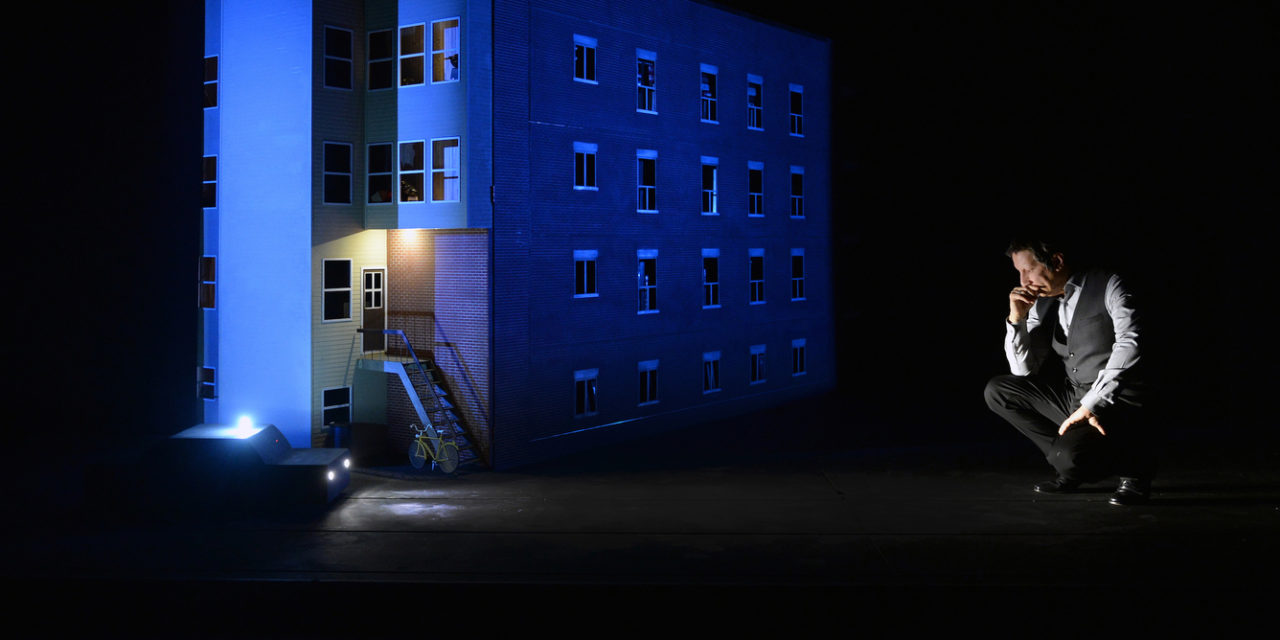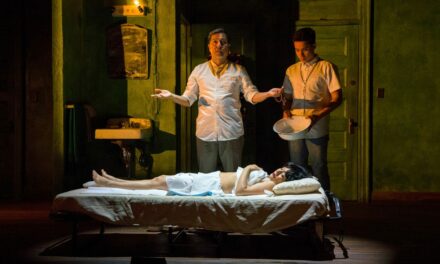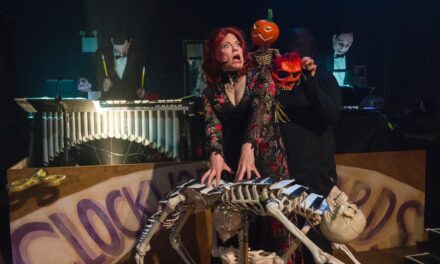Robert Lepage’s autobiographical show at the Melbourne Festival, 887, is named for his childhood apartment building: 887 Avenue Murray in Quebec City. Lepage wrote, designed, directed and performed 887, but to call it a one-man show does not give enough credit to the equal performance of the set.
Through a gloriously intricate series of folding boxes, scale models, and video projections, Lepage and his Ex Machina team presented the apartment building as a material “memory palace”. It’s a mnemonic device bought to life: the rememberer imaginatively “places” pieces of complex information in particular rooms of a familiar place and then mentally “walks” through the place to retrieve the information.
Like a number of recent productions in Melbourne, 887 made prominent use of screens and video projections. This time last year, the UK company Headlong’s Melbourne Festival production of 1984 included large-scale video projections, making an obvious link to surveillance technologies.
In April-May 2016, the Melbourne Theatre Company’s production of Miss Julie used live projection to extend the logic of stage naturalism as cameras followed the actors beyond the kitchen setting to film action offstage. And in May-June 2016, Eamon Flack’s production of The Glass Menagerie at the Malthouse Theatre (first staged at Sydney’s Belvoir Theatre) framed the stage with two screens of live-edited, soft-focused footage.
In 887, as in The Glass Menagerie, video projection was a technology of memory. In the first moments of the show Lepage, holding his mobile phone, reminded the audience to silence ours and went on to discuss how he no longer remembers his own phone number, because so much of what he needs to remember is stored in the phone itself.
By locating his phone number in the mobile rather than his mind, Lepage showed contemporary technology as externalizing memory. Lepage projected video from the phone onto a screen at various points during the show, for instance peering into the scale model apartments of 887 Avenue Murray – often with his comparatively gigantic face and fingers visible through the windows or manipulating the tiny furniture and inhabitants.
The externalization of memory has its pitfalls and limitations, which Lepage played for laughs. In one running gag, Lepage tried to leave his actor friend a voicemail, but he spoke so circuitously that he kept getting cut off before conveying the content of his message. Lepage finally tried to leave his mobile number, only to find that his friend’s mailbox was now full. I found this gag funny, not least for its obsolescence, since nowadays one needn’t leave one’s phone number when calling a mobile: the phone records it.
Recording technologies also enable forms of memory that predate the events they memorialize. The same friend, once summoned, turns out to be employed reading “cold cuts” – celebrity obituaries recorded in advance of their deaths – for Canadian radio. He has recorded Lepage’s cold cut, which Lepage manages to extract from him on USB.
In the ensuing scene, Lepage listened to his own obituary, reacting with a mix of ambivalence and outrage to the pre-recorded account of his artistic achievements. Lepage listened via headphones plugged into his laptop, so the audience did not hear the obituary; lowered lighting and Lepage’s bland and thunderous expressions suggested his dissatisfaction with the content.
887 also linked memory to the politics of language. Lepage narrates and then acts out his inability to memorize Québécois writer Michèle Lalonde’s 1968 poem Speak White, which he has promised to recite live at an event.
“Speak white” is a racist insult aimed at non-English-speaking Canadians, and Lalonde’s poem, written in French, protests linguistic oppression. Lepage said that he was unable to memorize Speak White because only a man as humble as his father, a taxi driver, had the right to speak the poem. But in a climactic scene, Lepage did recite the poem in French with English surtitles.
Scenes of immersive “plot” rather than “memory” – for instance, scenes involving Lepage and his friend, rather than Lepage’s account of his childhood in Quebec – were likewise spoken in French. Was the implication that Lepage had become as humble as his father? I think, instead, it was that Lepage inhabited a version of his father.
Can we mobilize the externalization of memory to political ends? Can we use it to wear our fathers’ bodies and to speak in voices stronger and more humble than our own? While these questions and the dazzling scenography bring the show beyond memoir, it is memoir that helps Lepage to answer them.
887 is showing at the Arts Centre Melbourne until October 22, 2016, and at BAM in NYC in March 2017.
.![]()
Sarah Balkin, Lecturer, English and Theatre Studies, University of Melbourne
This article was originally published on The Conversation. Reposted with permission. Read the original article.
This post was written by the author in their personal capacity.The opinions expressed in this article are the author’s own and do not reflect the view of The Theatre Times, their staff or collaborators.
This post was written by Sarah Balkin.
The views expressed here belong to the author and do not necessarily reflect our views and opinions.


















